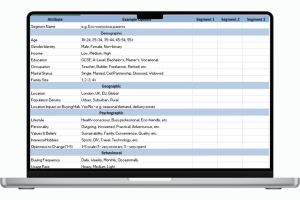For small businesses, marketing works best when it’s aimed at the right people. Trying to reach everyone usually means spreading your budget too thin and getting disappointing results. Customer segmentation helps you avoid this problem by breaking your audience into clear groups.
We’ve explained the concept in detail in our Market Segmentation for Non-Marketers guide, so in this article, we’ll focus on the practical side: how to use the Customer Segmentation Table to organise your segments, compare them, and choose where to focus first. The table includes fields such as demographics, behaviours, pain points, and scoring, so you can easily compare segments side by side and see where your best opportunities lie.

How to Use the Customer Segmentation Table
1. Start with 2–3 segments
The purpose of this step is to stop thinking of your customers as “everyone.” By defining two or three segments and comparing them side by side, you get a realistic view of the different groups you could serve.
Why it matters:
- It helps you see differences between groups that you might otherwise miss.
- It prevents you from spreading yourself too thin by trying to market to everyone at once.
- Even if you’re a startup, you’ll see which segment offers the best starting point while keeping the others for future growth.
2. Fill in the most relevant fields
The table has many fields because businesses are different. You don’t need to fill every box. Focus on the information that actually affects how your customers buy. For some businesses, psychographic details like lifestyle, values, or attitudes will be crucial. For others, geography or demographics matter more. Use the fields that give you insights into what shapes your customer’s decisions.
Why it matters:
- It saves time and keeps the process simple.
- It keeps you focused on the information that will actually influence your marketing decisions.
It prevents you from collecting irrelevant data that won’t change your decisions.
3. Define pain points, problems, and benefits
These are the sections that explain why a customer would choose you. While the other fields describe who your customer is, these fields uncover what drives them to act.
Why it matters:
- Pain Points show what frustrates your customers and what they want to avoid.
- Main Problem/Need explains the issue they want solved, which tells you exactly how to position your offer.
- Desired Benefits show what positive result they are looking for, which helps you create the right message.
This is the part of the table that turns raw data into actionable marketing.
4. Score Your Segments
Once you’ve filled in your table, scoring helps you decide which segment to focus on first. Without it, you could end up chasing a group that’s too small or too hard to reach.
How to score:
- Market Size (1–5): Estimate how many people fit this segment. Larger numbers score higher.
- Ease of Reach (1–5): Consider how easy it is to market to this group through your existing channels and budget.
- Profitability/Fit (1–5): Judge how much this segment is likely to spend and whether their needs match your offer.
- Competition (1–5): A lower score means tougher competition. If many businesses target the same group, you may need a unique approach.
- Strategic Fit (1–5): Check if this segment aligns with your long-term business goals.
When you score each segment, use simple, realistic estimates. You don’t need exact numbers. What matters is a clear comparison between segments.
5. Choose Your Priority Segment and Create a Profile
Once all segments are scored, add up the numbers. The segment with the highest total is usually the best place to start.
If you’re a small business or startup, focus on this segment first to make your marketing clear and effective. Keep the other segments in your table. You can come back to them later as your business grows and has more resources.
At this stage, it’s also helpful to create a simple customer profile based on your chosen segment. This doesn’t need to be complicated. Use the information from your table to describe a typical customer in a few lines.
This profile turns the data in your table into something you can picture, which makes it easier to adapt your offer and shape your marketing messages in the next step.
6. Adapt Your Offer for Your Chosen Segment
Customer segmentation on its own does not deliver results. It simply shows you where to focus. Once you’ve identified your priority segment, you need to take the next step: refine your offer so it matches what this segment values most.
This means reviewing and, if necessary, adjusting the following:
- Product: Highlight or adapt features that matter most to this segment.
- Price: Make sure your pricing fits what this group is willing to pay.
- Place: Focus on the channels and locations where they are most likely to engage with you.
- Promotion: Use the language, pain points, and desired benefits identified in the table to shape your marketing messages. Decide which assets and platforms you will use.
This is the Positioning stage of the STP framework, where you align your business with the needs of your chosen audience. (You can read more in our STP guide.)
By taking this step, segmentation becomes actionable. Over time, you can repeat the process for your other segments as your resources grow and your business expands.
7. Test, Learn and Refine
Customer segmentation is not something you do once and then forget. Your market changes, customers’ needs evolve, and your business will gain new insights over time.
After you’ve chosen your priority segment and adapted your offer:
- Test your approach: Run small experiments, such as targeted ads, limited-time promotions, or specific email campaigns.
- Measure what happens: Track meaningful results – sales, click-through rates, repeat visits, or customer feedback.
- Learn from the data: Identify what’s working and what isn’t. If one message or offer performs better, focus on it.
- Refine your table: Update your segmentation with what you’ve learned. You may need to adjust scores, add details to your chosen segment, or even add a new segment as your business grows.
By testing, learning, and refining, you make sure your segmentation stays relevant and continues to deliver results instead of becoming a static document.
Customer Segmentation Table – Coffee Shop Example
To make the Customer Segmentation Table easy to understand, let’s imagine a specialty coffee shop in central London:
- Location: Near offices, transport hubs, and tourist attractions.
- Positioning: Premium coffee with fast service and a clean, welcoming space.
- Menu: Specialty coffee, takeaway breakfast items (croissants, sandwiches, pastries), and quick lunch options.
- Goal: Grow weekday sales while capturing weekend and tourist traffic.
This context matters because it explains why we choose the segments we do. For this coffee shop, the table includes:
- Busy commuters (weekday regulars) – value speed and efficiency
- Weekend families (occasional but loyal if treated well) – value family-friendly options and a welcoming space where everyone feels comfortable.
- Tourists (one-off but high-volume visitors) – value convenience, a quick break, and affordable comfort while exploring.
By mapping these segments side by side, we can see who drives the most value and which group to focus on first if the coffee shop is just starting out.

Why Busy Commuters Are the Starting Point
When we score the segments, busy commuters come out on top:
- They visit daily.
- They are easy to reach through local marketing and Google Maps.
- They value speed and convenience, which aligns perfectly with the coffee shop’s positioning.
If this coffee shop were a startup, it should start with busy commuters first, then later add targeted offers for weekend families and tourists once it has the staff and systems in place.
The Customer Segmentation Table helps visualise this decision instead of guessing. It shows at a glance that while all three segments are important, the first campaign should target the group with the biggest immediate return.
Why This Customer Segmentation Table Works
The Customer Segmentation Table is a practical tool for turning a vague audience into clear, actionable customer groups. By mapping out your segments, scoring them, and focusing on the one with the strongest potential, you give your marketing a clear direction.
Start with what you know, keep it simple, and update your table as you learn more about your customers. Whether you’re launching a new business or refining an existing one, this framework helps you make informed decisions and prioritise the people most likely to buy from you.
Download the table, complete it with your own data, and use it as a living resource that evolves alongside your business. The clarity it brings will make every marketing pound work harder.
Ready to take the guesswork out of marketing? At Social Matrix, we help small businesses turn data into clear, actionable customer segments. We’ll work with you to identify your best opportunities and build strategies that get real results.
Contact us today and let’s turn your customer data into a clear, focused marketing strategy that helps your business grow.

